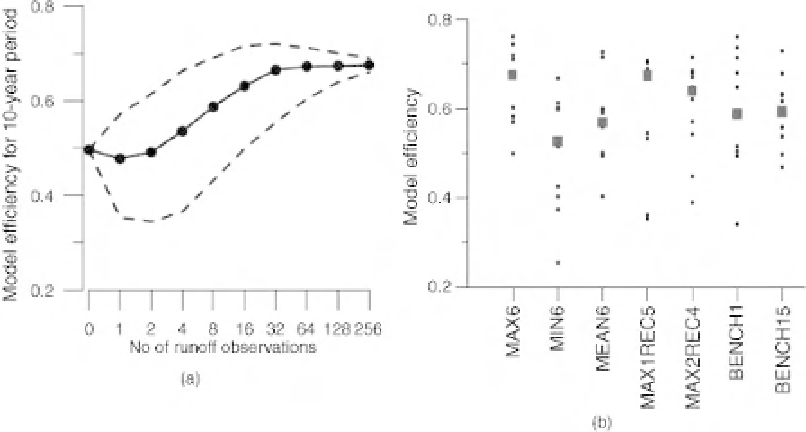Geoscience Reference
In-Depth Information
Figure 10.3
(a) Model efficiencies for the entire 10-year period of the weighted ensemble mean where the
ensemble has been selected based on
randomly chosen measurements during one year: the solid line and
the circles represent the median over all years, catchments and random realisations of the selection of
n
days;
the dashed lines show the medians of the percentiles (10% and 90%) for the different realisations of the
selection of
n
days; (b) performance of different strategies to select six days of observations during one year for
use in model calibration; black dots represent the median of 10 years for one catchment; squares represent
the median of all catchments (after Seibert and Beven, 2009).
n
sensing of flood inundation to condition the parameters of hydraulic models (e.g. Bates
et al.
, 2004;
Pappenberger
et al.
, 2007a, 2007b; Di Baldassarre
et al.
, 2009).
10.12 Key Points from Chapter 10
•
There has been significant progress in the problemof predicting the hydrological responses of ungauged
catchments in the last decade, in part because of the IAHS PUB intiative and theMOPEXproject. These
have the aims of improving both the science base for hydrological modelling and the functionality of
representing hydrology in data-sparse regions of the world in global modelling.
•
Classical regionalisation approaches used in estimating model parameters for ungauged basins have
been based on regression of fitted parameter values for gauged catchments against catchment charac-
teristics. The limitations of this approach are now generally recognised, though it continues to be used.
Statistical regressions can provide confidence limits for the estimated parameter values, but these are
often ignored.
•
Where data from a nearby upstream or downstream gauge are available, a simple area scaling of the
observed hydrograph to the ungauged basin is the model to beat.
•
Approaches based on a pooling group of donor catchments generally give (slightly) better results than
regresssions against catchment characteristics but differences are often small.
•
Recent work has suggested that a more effective approach to predicting the responses of ungauged
basins is the regionalisation of hydrograph characteristics that are then used to constrain an ensemble
of models. The ensemble approach allows the uncertainties in representing the ungauged catchment
to be addressed.

